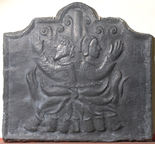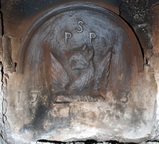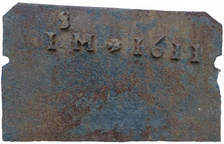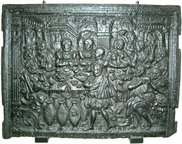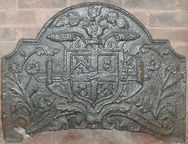-
239
Description: Arched rectangle with stepped, canted shoulders; fillet and astragal edging (top and sides only); initials above date at top of plate.
Notes: The shape and edging are uncommon. Formerly from Caerphilly, Glamorgan.
Inscription: D H / 1746
- Decoration tags:
- rectangular with canted top corners and round arch (shape)
- fillet (edging)
- individual letters
- individual numbers
- text
Manufactured: in 1746 in Wales.
Current location: National History Museum, St Fagans, Glamorgan, Wales.
Museum number: 44.303/1 (part of the Welsh National History Museum museum group)
- Attached to series:
- Date & initials firebacks
-
298
Description: Pentagonal with a small triangular arch, centre top; twisted rope edging (top and sides); in arch, cross formed of small fleurs-de-lys; row of small fleurs inside rope edging, lower half of sides plain; length of twisted rope each side, parallel to edges, with small fleur terminal at top end; upper centre, rope escarbuncle with fleur terminals between ‘R’ and ‘C’ (both of rope with fleur terminals, ‘R’ reversed); ‘A’ below escarbuncle (also rope with fleur terminals, with cross bar above); fleur cross below ‘R’.
Notes: Twisted rope with fleur terminals is seen on several firebacks with stamps otherwise associated; it is a form paralleled on firebacks from the Champagne area of France. The escarbuncle is the principal charge on the arms of the Duchy of Cleves, possibly associating this fireback with the brief marriage of Henry VIII and Anne of Cleves. Formerly at Warnham Court, Sussex; illustrated in Gardner 1898, p. 146.
Inscription: R A C [inverted triad]
- Decoration tags:
- rectangular with canted top corners and triangular arch (shape)
- rope (edging)
- simple stamps
- objects
Manufactured: in the mid- to late-16th century possibly at Pounsley Furnace, Framfield in the Weald area of England.
Current location: not known.
Citation: Gardner, J. S., 1898, 'Iron Casting in the Weald', Archaeologia, 56, 1, pp. 133-164.
- Attached to series:
- Pounsley series
- Rope design firebacks
- Fleur rope terminal series
-
308
Description: Arched rectangular centrel panel with bead on fillet edging; central seated female with an infant in her arms, a swan at her feet and a standing child on each side, the one to her left facing the front and holding aloft a flaming heart, its foot on a ball; the child to her right facing the back, holding aloft a branch in its left hand, all on a ground with a tree behind to the right; arched rectangular border with fillet edging; at the top of the arch a cartouche from which are suspended two ribbons, each held by a putto, from which cascade flowers and fruit, each lower part hung from a ring; two putti are on each side, one climbing on the suspended ribbon, the other at its foot; at the bottom, a cartouche containing the monogram between two clusters of flowers each suspended on a ribbon tied to a scroll; on top, two descending cornucopiae.
Notes: The scene portrays Charity; the same central panel can be seen with different borders, and also exists in other versions.
Copies of this fireback are known.
Inscription: HIS
- Decoration tags:
- 'Dutch' (shape)
- fillet (edging)
- whole carved pattern
- pictorial
- allegorical
- monogram
- text
- humans
Manufactured: in the late-17th century in the Siegerland area of Germany.
Current location: Hampton Court Palace, Richmond, Greater London, England.
Museum number: 1069 (part of the Royal Collection museum group)
- Attached to series:
- 'Dutch' HIS series
- Charity firebacks
-
324
Description: Rectangular with two-stepped top; undefined edging; in arch, stamp formed of a talbot statant guardant upon a wreath; date below crest; vertical carved billet stamped three times, the centre one higher than the other two, between the initials, below each pair of which is a cross stamp.
Notes: The talbot crest is seen on other firebacks indicating a common source; from a drawing in report 2553 of the Domestic Buildings Research Group (Surrey). The fireback is obscured behind a stove.
Inscription: 16 30 / IM EM
- Decoration tags:
- stepped (shape)
- simple stamps
- carved stamps
- heraldic
- text
- objects
Manufactured: in 1630 in the Weald area of England.
Current location: in private hands, Horne, Surrey, England.
- Attached to series:
- Talbot crest series
- Stepped firebacks
- Date & initials firebacks
-
396
Description: Cavetto-canted rectangle with arched top; astragal and cavetto edging (top and sides); pictorial; back-to-back figures of a bearded man and a woman in a poke bonnet, both dressed in tunics, their arms raised, respectively left and right; they are chained to a vertical pole; below, flames issue from vertically stacked logs, while smoke rises above them; the physical proportions of the figures are naïve, the man’s eyes being over-large, as are the hands of both.
Notes: The design is a free adaptation of an illustration from The Book of Martyrs by John Foxe (1563), a copy from a back originally noted at Brick Cottage, Burwash, Sussex, in 1871. This may be the design of fireback referred to in an enquiry printed in the St James's Chronicle, or British Evening Post, of 9 August 1788, which described it as 'having two Bishops burning at Stakes thereon' at a house in Warwickshire. At an auction sale in 2017 the same design of fireback was interpreted as the burning of Bishops Latimer and Ridley in 1555. Protestants were burnt to death at several Wealden locations as well as elsewhere in the south-east of England during the reign of Mary I, notably at Canterbury and Lewes. The subject of the fireback should be regarded as symbolic rather than commemorating any individual martyrs.
Copies of this fireback are known.
- Decoration tags:
- rectangular with canted top corners and round arch (shape)
- astragal with cavetto (edging)
- whole carved pattern
- pictorial
- historical
- humans
Manufactured: in the late-16th to early-17th century in the Weald area of England.
Current location: Anne of Cleves House, Southover High Street, Lewes, East Sussex, England.
Museum number: LH000.903 (part of the Sussex Archaeological Society museum group)
Citation: Butterfield, W. R., 1916, 'Old Wealden Firebacks', The Connoisseur, 46, pp. 197-209.
Citation: Dawson, C., 1903, 'Sussex Iron Work and Pottery', Sussex Archaeological Collections, 46, pp. 1-54.
Citation: Paine, C., Aug 2013, 'Mystery of the Two Martyrs', Sussex Past and Present, 130, pp. 6-7.
Citation: Straker, E., 1931, Wealden Iron (London, Bell).
- Attached to series:
- Commemorative firebacks
-
501
Description: Arched rectangular shape; ovolo-moulded edging; central crest of a gryphon's head couped, its wings displayed; above, the initials, the 'S' above the 'P's; below, the date.
Notes: The crest is likely to be that of Peter Short of Lindfield, Sussex, who married Philadelphia Burrell in 1704.
Inscription: PSP / 1730
Arms: Short of Lindfield
- Decoration tags:
- rectangular with round arch (shape)
- ovolo (edging)
- carved stamps
- individual letters
- individual numbers
- heraldic
- text
Manufactured: in 1730 possibly in the Weald area of England.
Current location: in private hands, Newick, East Sussex, England.
- Attached to series:
- Personal firebacks
- Date & initials firebacks
- 1730s-40s, date & initial series
-
1167
Description: Canted quasi-rectangular shape; no edging; parallel with top edge, initials in triad to left, separated from date by a small, ill-defined flower stamp.
Notes: The serifed character set is boldly impressed, although the S is indistinct, suggesting that some of the moulding sand may have filled the impression before casting. The indentations on each side were cut to accommodate mouldings. Tennants Auctioneers sale, Leyburn, North Yorkshire, 20 March 2015, lot 781.
Inscription: ISM [triad] 1611
- Decoration tags:
- rectangular with canted top corners (shape)
- none (edging)
- individual letters
- individual numbers
- text
- plants
Manufactured: in 1611 in England.
Current location: not known.
- Attached to series:
- Date & initials firebacks
-
731
Description: Rectangular with flanged edging and a moulded frame; pictorial scene of the Marriage at Cana in an architectural setting; inscription along bottom edge.
Notes: The pattern-maker is believed to be Master Ronnung.
Inscription: HISTORIA VON DER HOCHZEIT ZV CANA IN GALILEA ...
- Decoration tags:
- rectangular (shape)
- flanged (edging)
- whole carved pattern
- pictorial
- biblical
- text
- humans
- objects
Manufactured: in the late-16th century possibly in the Harz area of Germany.
Current location: Victoria & Albert Museum, Cromwell Road, Kensington & Chelsea, Greater London, England.
Museum number: 319.1897 (part of the Victoria & Albert Museum museum group)
Citation: Dawson, C., 1903, 'Sussex Iron Work and Pottery', Sussex Archaeological Collections, 46, pp. 1-54.
Citation: Gardner, J. S., 1898, 'Iron Casting in the Weald', Archaeologia, 56, 1, pp. 133-164.
- Attached to series:
- Stoveplates
- Marriage at Cana stoveplates
-
43
Description: Arched rectangular shape with ovolo canted top corners; fillet edging; within a cartouche, shield of the Worshipful Company of Barber-Surgeons - quarterly, first and fourth, Sable a Chevron between three Fleams Argent, second and third, Per pale of the second and Vert on a Spatter also Argent a Tudor Rose proper crowned Or; on a Cross Gules dividing the quarters a Lion passant guardant Or; the date is above the shield, which is surmounted by a vase from which are displayed a flower and leaf stems; the same occupy the spaces on each side of the shield, below which is a motto scroll.
Notes: The arms on this fireback were granted to the company in 1569.
Copies of this fireback are known.
Inscription: 1631
Arms: Worshipful Company of Barber-Surgeons
- Decoration tags:
- rectangular with canted top corners and round arch (shape)
- fillet (edging)
- whole carved pattern
- heraldic
- armorial
- text
Manufactured: in 1631 possibly in the Weald area of England.
Current location: not known.
- Attached to series:
- Livery company firebacks
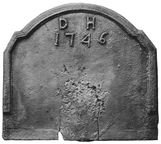
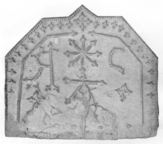
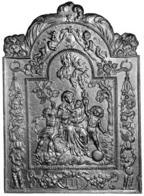
.jpg)
